Our planet never ceases to amaze us with its beautiful treasures. But as breathtaking as some places may be, we don’t always know everything about them. The mysteries that surround them make them even more intriguing and desirable destinations for travelers. Here are 10 of the most mysterious places on Earth.
1. Angkor Wat, Cambodia
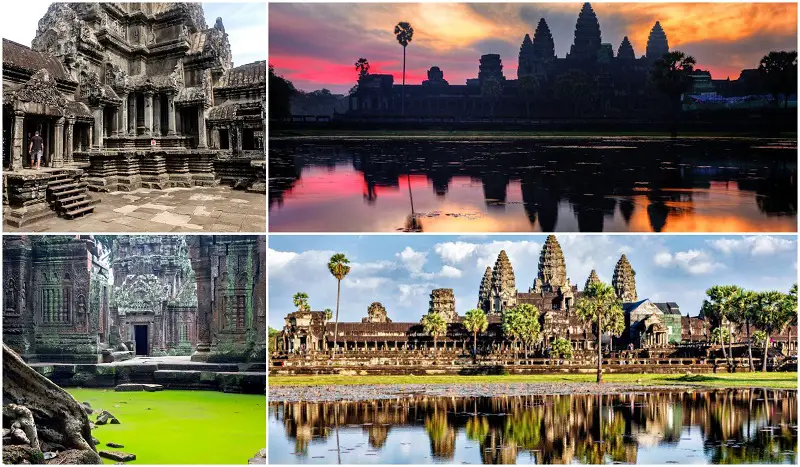
Angkor Wat was the first religious temple built in Cambodia and the largest one in the world. It took 30 years for the site to be completed, starting in A.D. 1113. The temples were originally honoring the Hindu god Vishnu. The central tower was supposedly where Shiva’s spirit resides. But some hundreds of years later, Angkor Wat was turned into a Buddhist site. One of the most impressive things about it is the intricate sculptures and carvings. In fact, it is said that the whole site is built with mathematical precision and used to serve astronomical purposes.
Interesting Facts
- Site: a 3-level, 248 square miles pyramid surrounded by water, constructed on a floating piece of land
- Features: a former urban city of the 9th century; 2,000 carvings of nymphs; 1,796 women portraits carvings; bas-relief built to mark the winter and summer solstices.
- Tourism: 2 million travellers per year; 50% of people who come to Cambodia come for Angkor Wat.
2. Easter Island, Chile
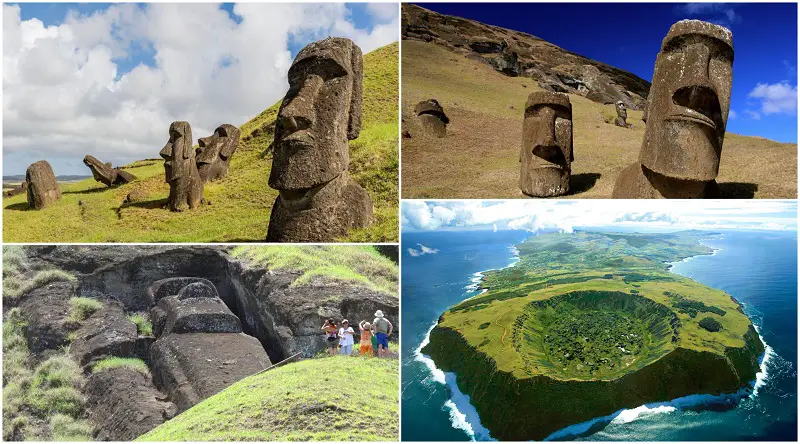
Easter Island is a small, secluded, and mysterious place located in the southeastern part of the Pacific Ocean, in the Polynesian Triangle. The territory is in the administration of Chile. Also known as Rapa Nui, the enigma of the land goes back some centuries. This was when a group of Polynesian people traveled by sea to settle here. Their reasons for doing so are to this day, unknown. The newcomers found a paradise full of various trees, especially palms – the largest palm species in the world. They used them to build shelters, clothing, and canoes. The climate and vegetation were creating ideal living conditions. 250 years later, the island was abandoned because its resources were exhausted by the overgrowing population. The most known symbols of the Easter Island are the 13 feet tall monolithic Moai statues, carved by the Polynesians.
Interesting Facts
- Site: a 63-square-mile island, located 2,300 miles west of South America with aprox. 5,000 inhabitants.
- Highlights: 13-feet tall Moai statues, standing on the Ahu ceremonial platforms, Rano Kau and Rano Raraku volcanic craters, 2 beautiful white sand beaches, Anakena and Ovahe, and caves.
- Tourism: 50,000 visitors a year.
3. Blood Falls, Antarctica
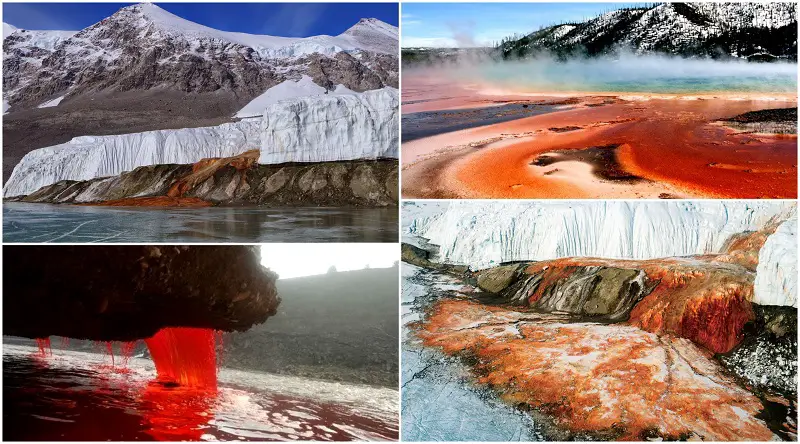
Blood Falls is a crimson-colored waterfall in McMurdo Dry Valleys, Antarctica, with its source in the Taylor Glacier. The mysterious landmark has a geological explanation. The 5-story waterfall was discovered in 1911, but the phenomenon dates back to 2 million years ago when a salt lake was covered by the glacier. The color red comes from the high iron content of the lake, which pours through a fissure in the glacier.
Interesting Facts
- Site: a red waterfall coming down from the Taylor Glacier comes from high iron content.
- Did you know: the water source of Blood Falls is cut off from the atmosphere and yet bacteria live there; this shows how life can exist in the most extreme conditions.
- Tourism: 37,000 people per year visit Antarctica, but the waterfall can only be reached by helicopter or cruise ships on the Ross Sea.
4. Stonehenge, England
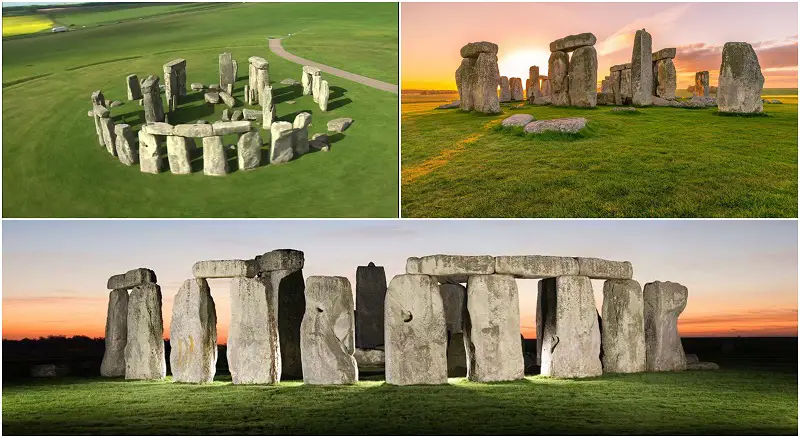
Stonehenge is one of the most well-known British landmarks and one of the most mysterious. The site, located on Salisbury Plain in Wiltshire, England, consists of 100 huge stones arranged in a circle, built sometime in 2600 BC. The whole construction took the Neolithic builders around 1,500 years. Many scholars believe that Stonehenge used to be a burial ground. But how the enormous construction was built without technology in those times remains a mystery.
Interesting Facts
- Site: prehistoric monument consisting of 100 megaliths located in southern England.
- Theories: the purpose of the moment is unknown; some say it was built for human sacrifice, others for astronomy and others for burial ground.
- Tourism: 1 million tourists per year.
5. The Travertines of Pamukkale, Turkey
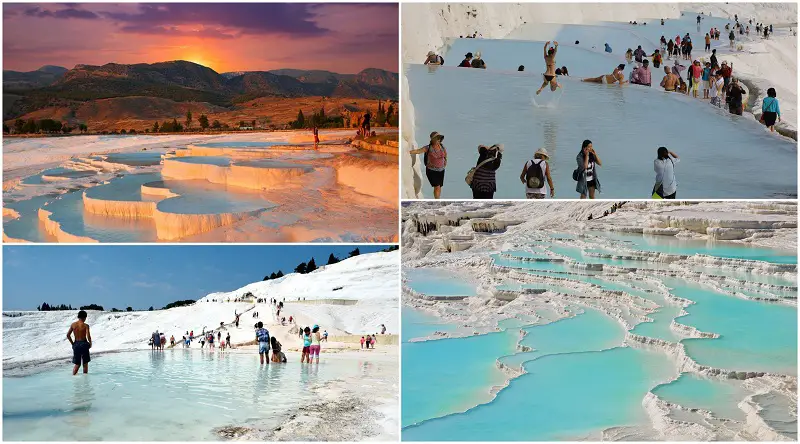
The Travertine Terraces in Pamukkale, are one of the most visited attractions in Turkey and considered an 8th wonder of the world. Located in the vicinity of the Roman city of Hierapolis, the carbonate minerals pools are shaped by hot springs. The result resembles a cotton castle, which is actually what ‘Pamukkale’ literally means. There are numerous health benefits to the hot springs, which is one of the reasons the site always had a large number of visitors.
Interesting Facts
- Site: a group of travertines and hot springs in Pamukkale, Turkey.
- Highlights: Enchanting view of a cotton castle-looking site with turquoise lagoons; therapeutic effects of the hot mineral springs.
- Tourism: 1.5 million tourists per year.
6. Fly Geyser, USA
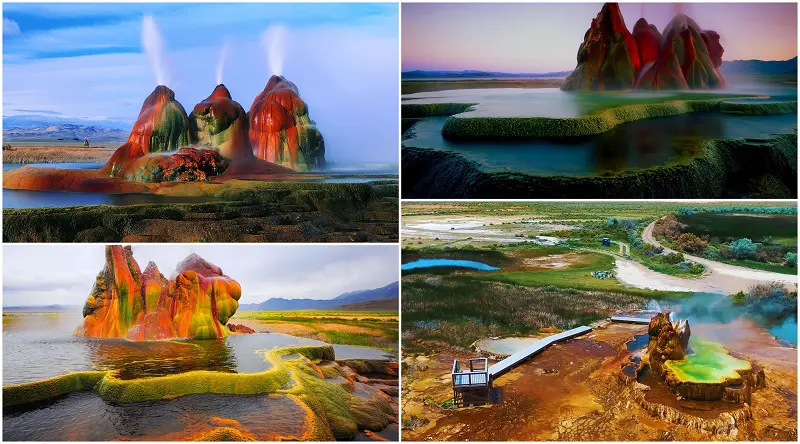
Fly Geyser is not a natural landmark, but a beautiful man-made accident. The geyser, located in Nevada, was created during well drilling in 1916. The hot water started bursting out of it in 1960 though, when one of the geyser’s walls was cracked. The beautiful colors are given by the multitude of minerals the attraction is made of.
Interesting Facts
- Site: Man-made geyser.
- Highlights: Spectacular view resembling a green and red alien because of the thermophilic algae.
- Tourism: very little known attraction, located on private property but accessible on request.
7. Aokigahara Suicide Forest, Japan
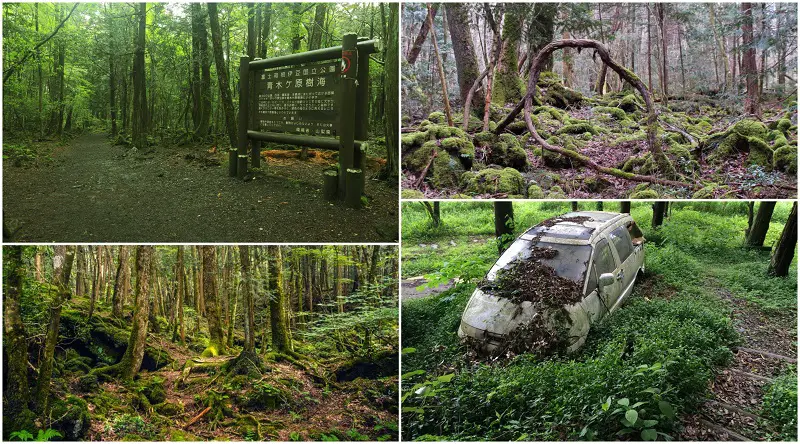
Aokigahara is a mysterious Japanese forest located at the base of Mount Fiji, popularly known as the Sea of Trees or the Suicide Forest. The forest covers about 35-square kilometers and its floor is made of volcanic rock. Some of its caverns are go-to places for tourists. But the really interesting thing about Aokigahara is that it’s a very popular place for suicides. It’s the second most popular in the world after Golden Gate Bridge. The unfortunate chain of events started with a 1960 book by Seicho Matsumoto called “Black Sea of Trees”, where a couple commits suicide in this forest. Ever since then, around 500 suicides have been reported. As legend has it though, the habit existed long before the book, especially in times of famine. It is now believed that the numerous suicides have caused paranormal activity within the forest.
Interesting Facts
- Site: a 35-square-kilometer forest located at the base of Mount Fiji, Japan
- Hiking: some visitors come here during the day to hike, as the thick forest of twisted vines offers a nice view during the night. Going through the forest can only be a pleasant experience for extreme thrill-seekers as you can always trip on dead bodies.
- Tourism: not a common place to visit for tourists.
8. The Bermuda Triangle, Atlantic Ocean
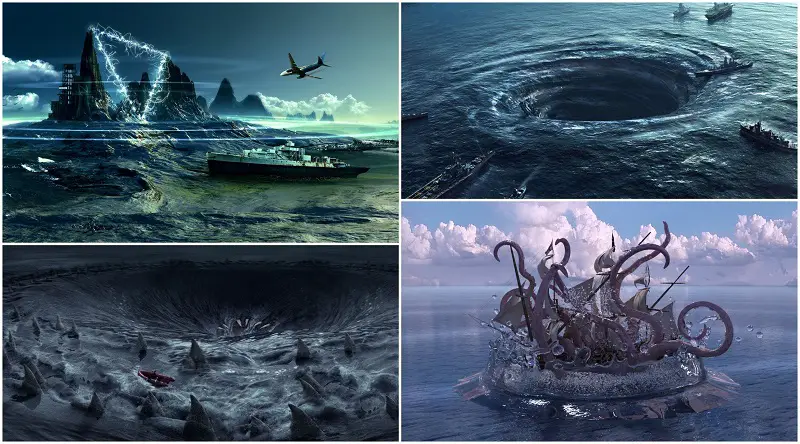
Not only is the exact location of the Bermuda Triangle questioned, but so is its very existence. Also known as the Devil’s Attraction, this portion of the Atlantic Ocean is by and large bordered by Miami (Florida), Bermuda Islands, and Puerto Rico. The US Navy denies its existence, and so does the US Board on Geographic Names. The mystery of the Bermuda Triangle started as early as 1492, when Christopher Columbus noticed that his compass was not functioning properly in that area. The name of this mysterious place was coined by Vincent H. Gaddis in 1964. He was investigating why so many planes and ships disappeared in the Bermuda Triangle. Theories attempting to explain the phenomenon blame it either on a magnetic anomaly, coincidence, methane eruptions in the ocean soil or extraterrestrial activity.
Interesting Facts
- Site: a triangle-shaped water portion in the West of the North Atlantic Ocean with its vertices in San Juan, Puerto Rico, the Bermuda Island and Miami, Florida.
- Mystery: the site is an unsolved mystery because of the 11 disappearances (planes, ships and 1 incident on land).
- Tourism: not a tourist attraction.
9. Mount Roraima
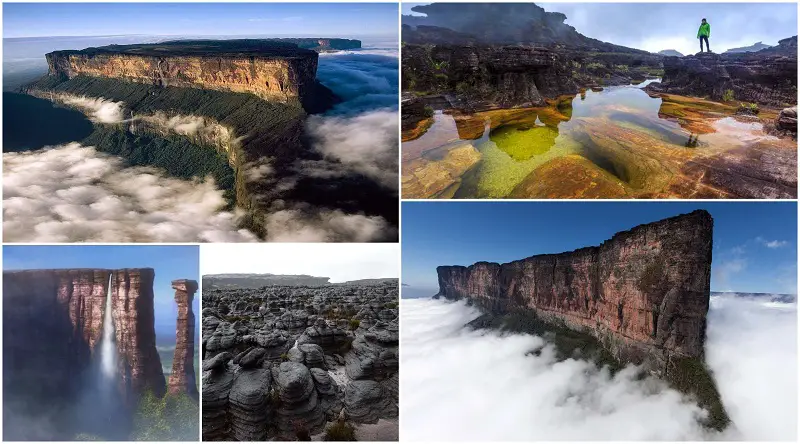
Mount Roraima is the highest mountain belonging to the South American Pakaraima chain. It’s one of the oldest geological formations in the world. The unique aspect of Mount Roraima, a tepuy or a table mountain, is its tabletop, which covers a 31-square-kilometre area. This flat summit is surrounded by 400-meter-tall cliffs and is bordered by Guyana, Brazil, and Venezuela. The mountain is as old as 2 billion years old and it experiences daily rains. It developed a spectacular ecosystem with rare species such as a carnivorous pitcher plant and huge waterfalls.
Interesting Facts
- Site: a 2,800-meter tall table mountain with a 31-square-kilometre wide summit, bordered by Guyana, Brazil, and Venezuela.
- Activities: numerous natural attractions; hiking experience suitable for amateurs as well.
- Tourism: moderately popular attraction; tourists are able to visit it on their own or through guided tours.
10. Salar de Uyuni, Bolivia
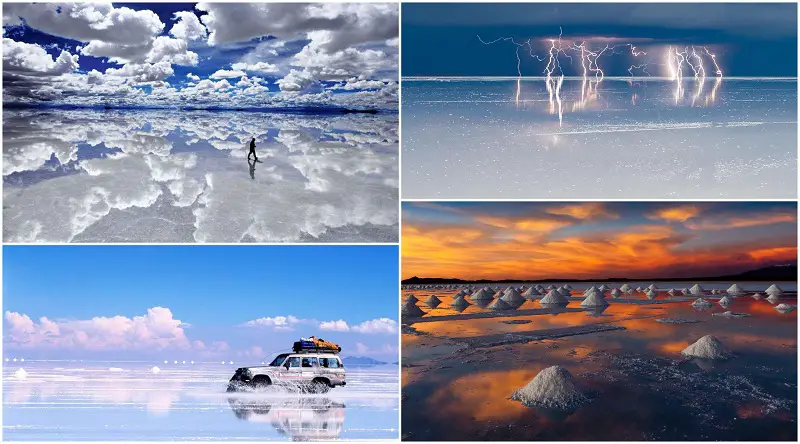
In the southwest of Bolivia lies the largest salt flatland in the world, and also the widest mirror – Salar de Uyuni. This 3,800 square miles of land is naturally divided in hexagonal tiles. It is created by salt crystals and houses 70% of the existent lithium on the planet. Salar Uyuni has been created through the transformation of a few prehistoric lakes. You can see it in two stages. In the wet season, the desert turns into a wide lake that mirrors the sky. During the dry season, the area is covered in sea crust tiles. Another amazing thing about this attraction is that despite the extreme climate, there is still life here. Among the life forms that live here are pink flamingos, hummingbirds, and ancient species of cacti.
Interesting Facts
- Site: 10,582-square-kilometre salt flat located in Soutwestern Bolivia.
- Highlight: Salar de Uyuni is a great visiting experience in any season and it one of the greatest photo locations in the world.
- Tourism: popular attraction; visits are best done on 4X4 tours.
These are just some of the strange and mysterious places on our planet, and certainly not all are recommended attractions. However, our environment does tend to naturally find a way to create some amazing landmarks and places of curiosity. We’re sure there are many more out there. Let us know if you’ve come across some odd places on Earth in the comments below!











